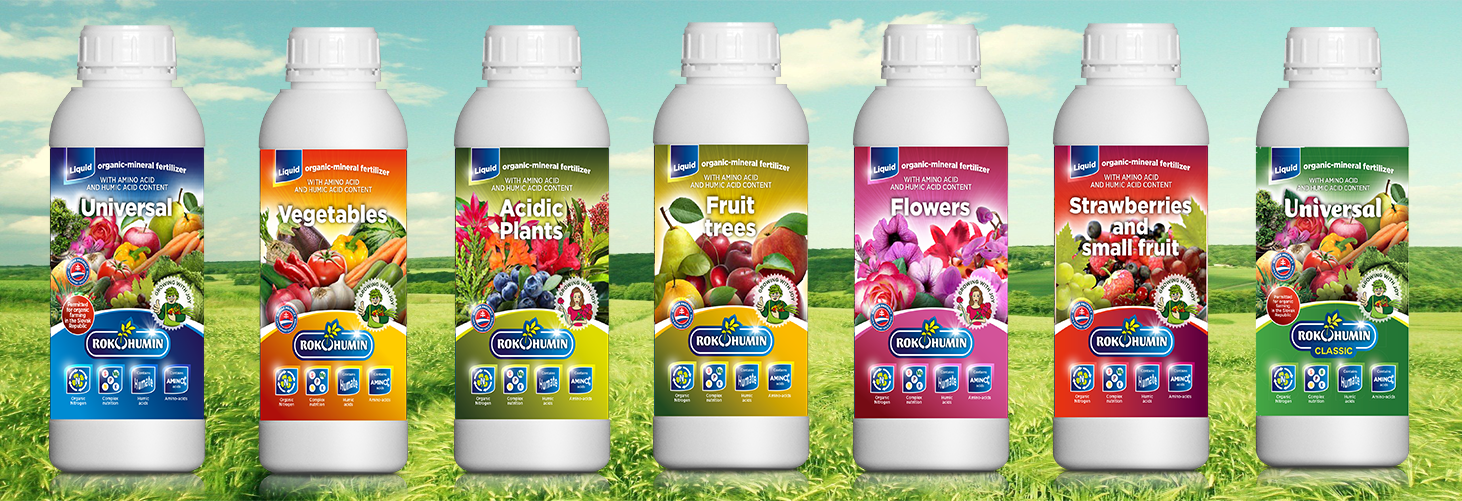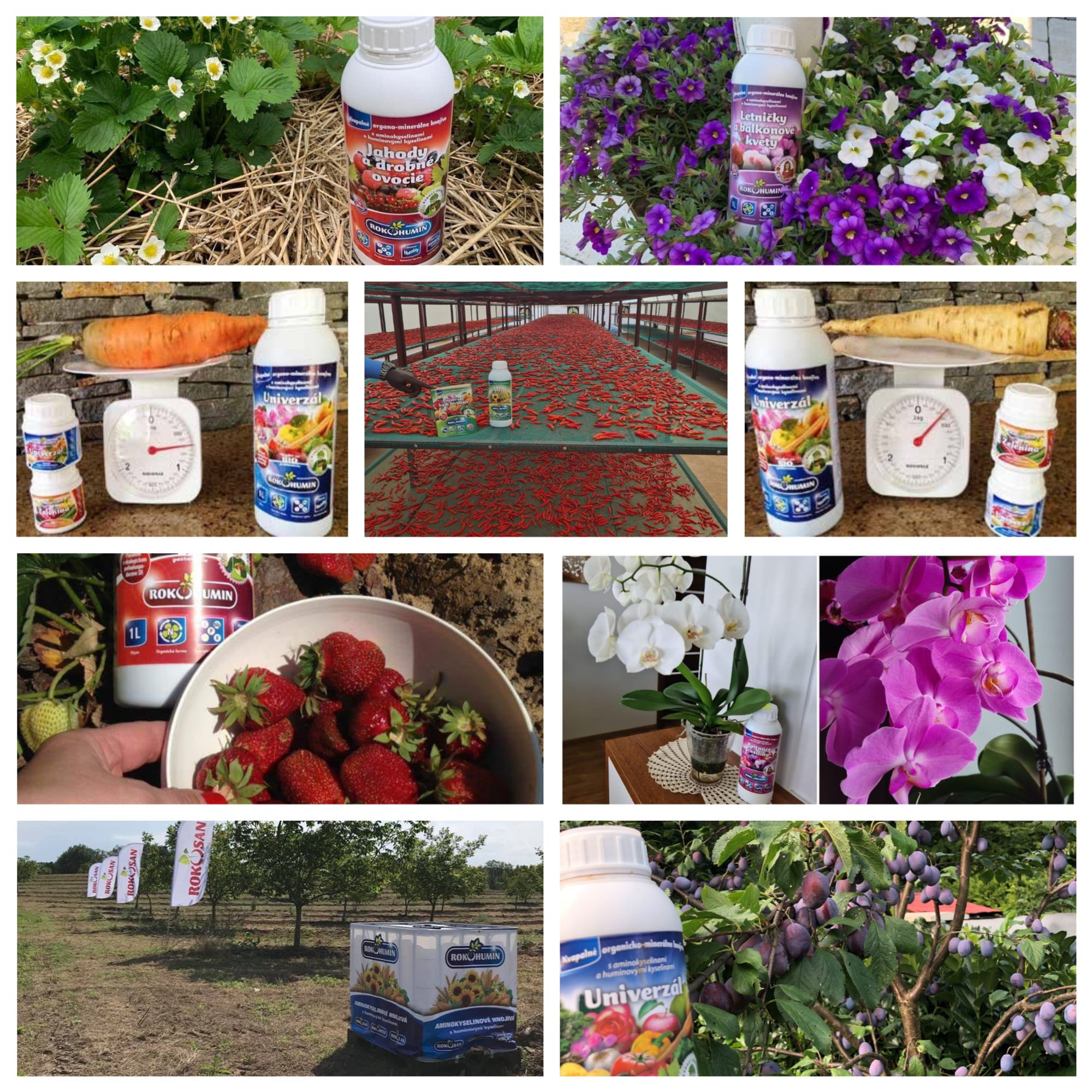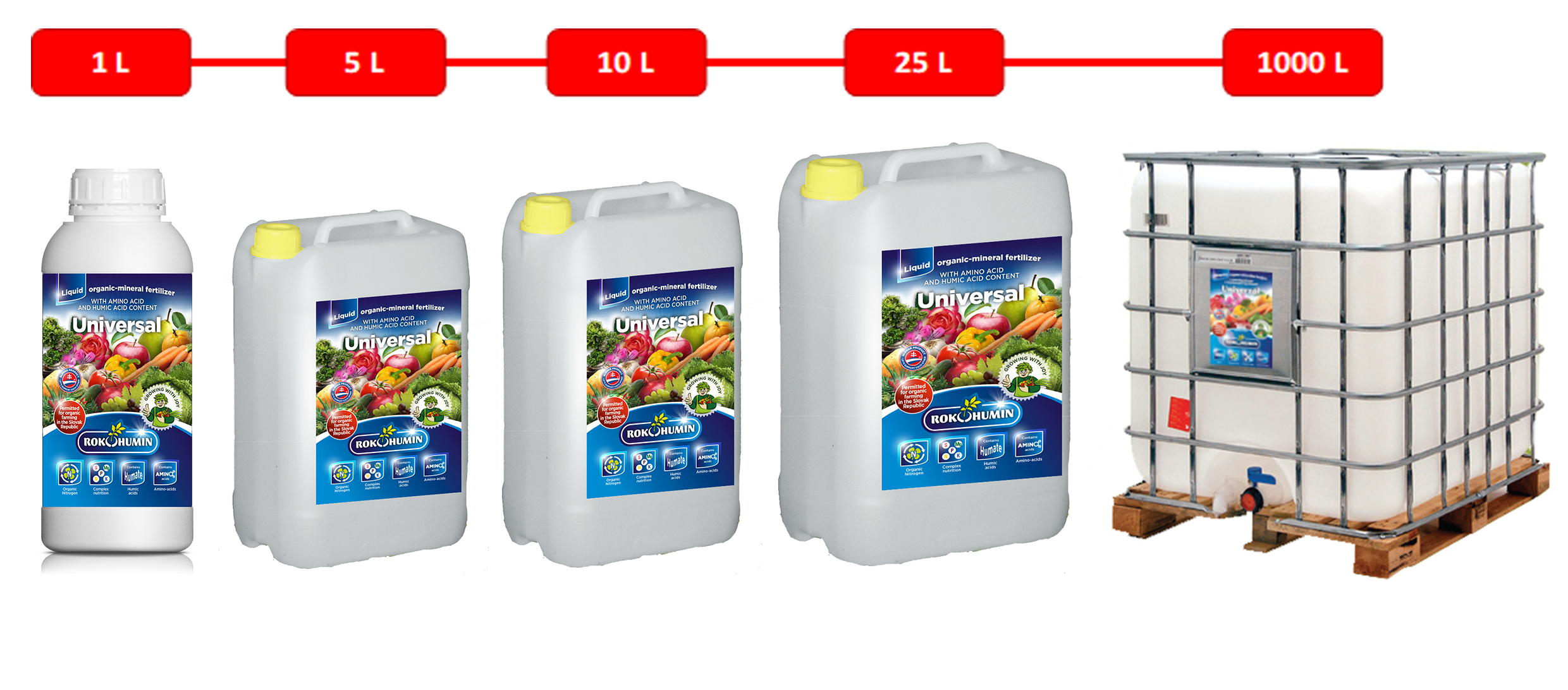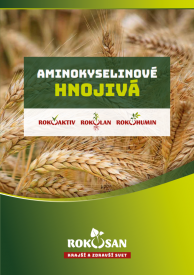ROKOHUMIN - universal liquid of humic acids in fertilizer organic-mineral fertilizer containing humic acid and amino acid
ROKOHUMIN - Liquid amino acid fertiliser containing amino acids, peptides, humic acids, macro and micronutrients for foliar application. Product stimulating of growth, promoting nutrient intake, increasing the resistance of plants to fluctuations in weather.

The advantage of foliar nutrition is the provision of a sufficient nutrient variety of living plants, which are very important. Corrects a deficit in a fastest way possible, or if the uptake through the roots is limited for some reason (for example, the pH of the environment). Leaf application is quickly ingested by the plant and its effect is therefore soon visible.
TRADITIONAL VARIANTS OF ROKOHUMIN
- Universal (NPK 14-9-14)
- Fruit trees (NPK 11-12-12)
- Annual flowers (NPK 21-15-12)
- Strawberries and small fruits (NPK 9-10-14)
ECOLOGICAL VARIANTS OF ROKOHUMIN
- Vegetables (NPK 5-10-14)
- Acidic plants (NPK 5-16-14)
- Classic (NPK 4-9-14)
ADVANTAGES
- Allows better rooting
- Improves root hair formation, root length and thus nutrient uptake from the soil
- Extends the growing season of fruiting vegetables and fruit
- Improves metabolism and natural resistance to diseases and pests
- Increases overall plant vigor
- Helps to increase soil fertility by promoting soil microflora (revitalises the soil)
- Prevents the accumulation of heavy metals and harmful substances in plants
- Increases the nutritional value of fruit
- Improves the typical colour of the fruit
- Extends the growing seasons
- Increases the chlorophyll content of the leaves
- Strengthens resistance to weather fluctuations and helps regenerate damaged plants
- Copper and sulphur content provides resistance to fungal diseases in the early stages of growth and development
- Can be applied foliar, by dressing or in hydroponic cultivation.
CHARACTERISTICS OF LIQUID FERTILIZER ROKOHUMIN
- Multicomponent liquid organic-mineral fertilizer made from an organic material rich in nutrients.
- Fertilizer has universal application and is intended to fertilize all kinds of plants and crops: vegetables, fruits, flowers, trees and shrubs, grass lawns.
- Contains nutrients in naturally form and is recommended and approved for use in organic farming.
- It is applied by spraying leaves, watering or drip irrigation system.
- Fertilizer has very good adhesion to the leaves and is resistant to rapid
drying and flushed. - Allows an application all day.
WHAT YOU GET BY USING ROKOHUMIN FERTILIZER
- Grow crops in BIO quality
- Your plant will be bigger and your crops richer in nutrients
- You are able to grow plants intensively and at the same time naturally
- Every € 1 invested in fertilizer will be returned to you several times over
WHY USE ROKOHUMIN FERTILIZERS
- increases the nutritional value of fruits
- allows a fast growth start and better rooting
- improves root hair formation and nutrient uptake from soil
- improves metabolism and nutrient management
- improves the overall condition of plants and resistance to diseases and pests
- improves the typical color of the fruit
- helps to plant flowers
- prolongs the growing season
- increases the chlorophyll content in the leaves (the plant has a deep green leaf color)
- strengthens resistance to weather fluctuations and helps regenerate damaged plants
- the content of copper and sulfur ensures the resistance of plants to fungal diseases in the initial stages of growth and development
EFFECTS OF HUMIC ACIDS IN FERTILIZER
- they affect the development of the root system and increase germination
- they are a natural growth stimulator
- increase chlorophyll content, help improve photosynthesis
- prevent the accumulation of heavy metals and harmful substances in plants and fruits (when fertilizing the soil)
- help increase soil fertility (when fertilizing the soil)
EFFECTS OF AMINO ACIDS IN FERTILIZER
Amino acids in fertilizer are needed for plant growth, regeneration and development. They are also of great importance for the soil microflora by promoting the activity of soil microorganisms and enzyme activity. Plants are able to synthesize all the amino acids they need. Many amino acids are precursors or activators of phytohormones and growth agents in plants.
In stressful situations, the plant is able to accumulate a significant amount of free amino acids, which act as a protective mechanism. The significance of this accumulation is that the plant spends less energy on protein synthesis. If the supplied amino acid is in the form of leaf nutrition, the plants will be in better conditions, which will affect growth and development. Thus, when a plant has individual building elements at its disposal and does not have to create them, its construction progresses at a faster pace.
PROLINE - contributes to the strength of the cell wall, increases the resistance of plants to stress factors and reduces the risk of damage, increases the ability of pollen to fertilize the plant and fruit.
GLYCINE - increases the concentration of chlorophyll and thus improves the conditions of the photosynthetic process, has a positive effect on pollination and fruit formation
GLUTAMIC ACID - affects osmotic processes in protoplasm and affects the opening and closing of vents, has a positive effect on pollination, activates seed germination, participates in nitrogen metabolism and protein synthesis
METHIONINE - is a precursor of ethylene, strengthens the development of roots, regulates the opening of vents
TRYPTOPHAN - a precursor of auxin (phytohormone, which supports the growth and strengthening of young roots, stimulates the growth of meristematic tissues), helps to overcome stress and prevents growth retardation.
ARGININE - increases the synthesis of hormones associated with the formation of flowers and fruits and facilitates the penetration of soil nutrients into the roots
ALANINE, VALINE and LEUCINE - helps to improve the quality of fruits
HISTIDINE - promotes maturation
SPRAY APPLICATION
- represents a simple and targeted application where we supply the plant with nutrients and missing elements quickly and in a targeted manner
- in the initial phase of vegetation it ensures fast growth and increased resistance of plants to diseases and weather fluctuations
- allows to improve the overall condition of plants with relatively low costs
- allows application together with products for protection against weeds, diseases and pests
- the fertilizer is applied during the initial growth phase of the plant / crop and during the regenerative fertilization period
- in general, it starts to be applied at 40-50% of the soil cover with leaves, so that the leaf area is sufficient for efficient intake of nutrients from the fertilizer
- do not apply during flowering!
- protection period is 2 weeks, fertilizer is not applied min. 2 weeks before harvest
- When applied in the garden, mix the contents of the bottle thoroughly, add 10 - 15 ml of concentrated fertilizer to one liter of water and, after mixing, apply by spraying on a leaf. For field crops, dilute 5 liters of fertilizer to at least 150 liters of water and use this solution to spray the leaves (densely sown cereals, oilseed rape, sunflower, legumes, potatoes ...). Fertilizing on a leaf is best in the evening, after sunset. If fertilized in sunny weather, the plant may be damaged. We can repeat fertilization after 25 days, especially for ornamental lawns and grassy areas, flowering and evergreen plants, grapes and small fruits.
APPLICATION BY WATERING OR DRIP IRRIGATION
- allows even and fast intake of all fertilizer components
- enriches the soil with an important organic component
- activates the process of mineralization in the soil, which leads to the release of nutrients from the soil
- helps in the formation of humus in the soil
- Homogenize the contents of the bottle as in the previous example and measure 15–20 ml of concentrated fertilizer per liter of water. Water the plants to the roots with the solution. It is very advantageous to fertilize before the rain, respectively watering the plants when the fertilizer gets deeper to the roots of the plant with the help of water. The positive effect of fertilization is manifested within two to three days. We recommend combining ROKOHUMIN in liquid form with loose Rokohumin, which has previously been incorporated into the soil. The effect of this combination is even more pronounced. After 30 days, repeat the fertilization with liquid ROKOHUMIN.
HYDROPONIC PLANT CULTIVATION
Mix the contents of the bottle thoroughly to homogenize it and pour 15 ml of the homogenized fertilizer into one liter of water. Pour the solution prepared in this way into a hydroponic container. After 14 days, change the solution.
PACKAGING
FIELD TEST RESULTS
CATALOGUE OF PRODUCTS












